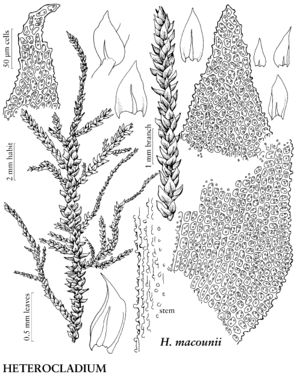Heterocladium macounii
Bull. Torrey Bot. Club 28: 127, plate 14, figs. 1–19. 1901.
Stems with epidermal-cells distinctly multipapillose. Leaves erect-appressed when dry, erect when moist; stem-leaves to 1 mm; margins papillose-serrate; apex acute to short-acuminate; costa single and frequently 2-fid or double to mid leaf; laminal cells papillose, papillae 2–4 per lumen.
Habitat: Rock, rarely other substrates
Elevation: low to moderate elevations
Distribution

B.C., Alaska, Calif., Idaho, Ky., N.C., Oreg., Tenn., Wash., Mexico, Central America (El Salvador)
Discussion
Heterocladium macounii grows almost exclusively on rock throughout its range and is only rarely collected on the other substrates frequented by the other two North American species. In the field, H. macounii can be difficult to separate from H. dimorphum, but the small, distinct stem papillae and multiple laminal cell papillae are good distinguishing traits of the former. There have been observations that H. macounii grows exclusively on rock; though this is generally the case, a few collection labels mention soil over rock or humus. Displaying a classic Arcto-Tertiary disjunct distribution reported for some bryophytes, the species is found in North America in the southeastern and northwestern United States and Alaska. Recently it has also been reported at high elevations in Mexico and El Salvador.
Selected References
None.
